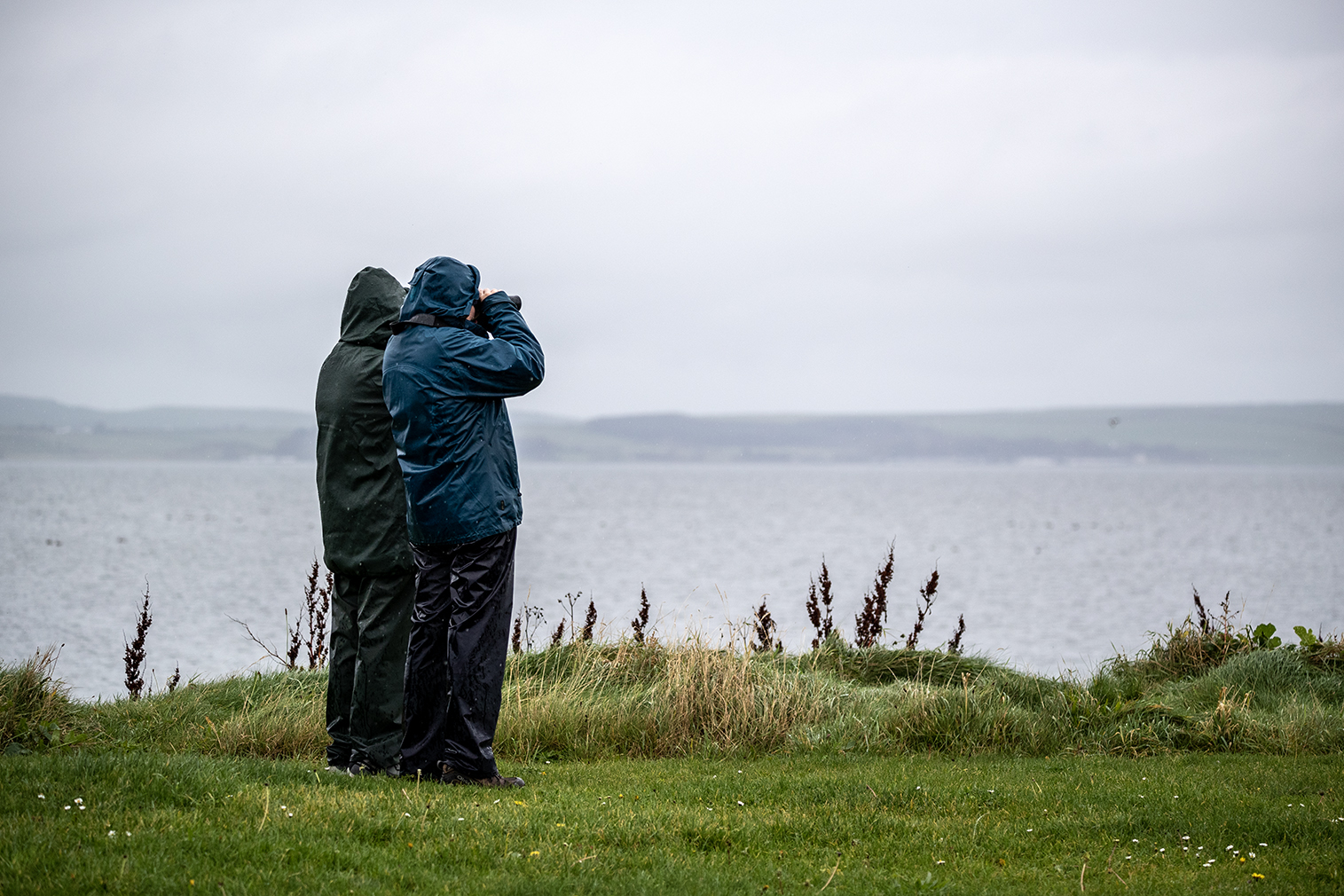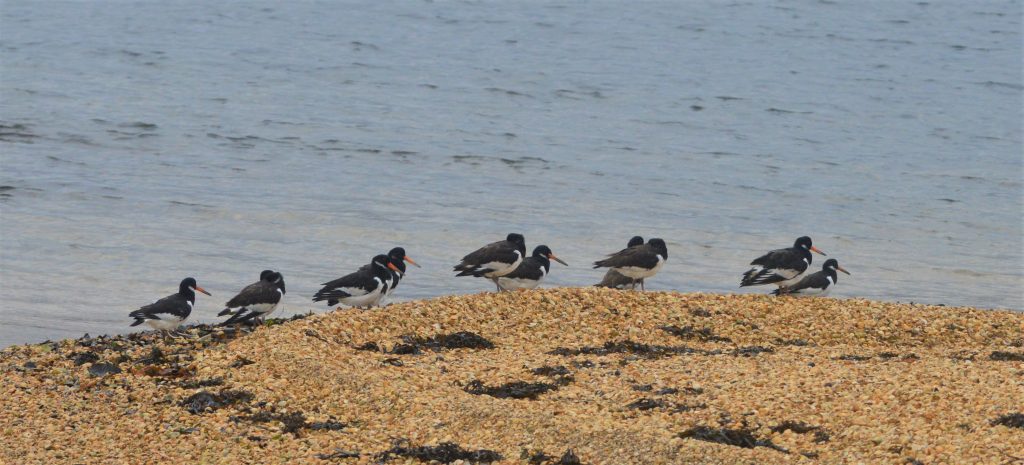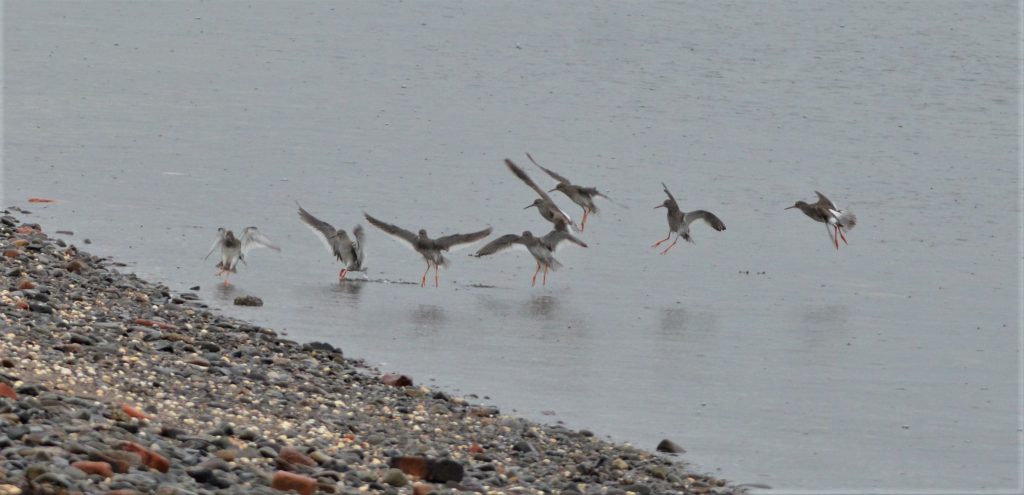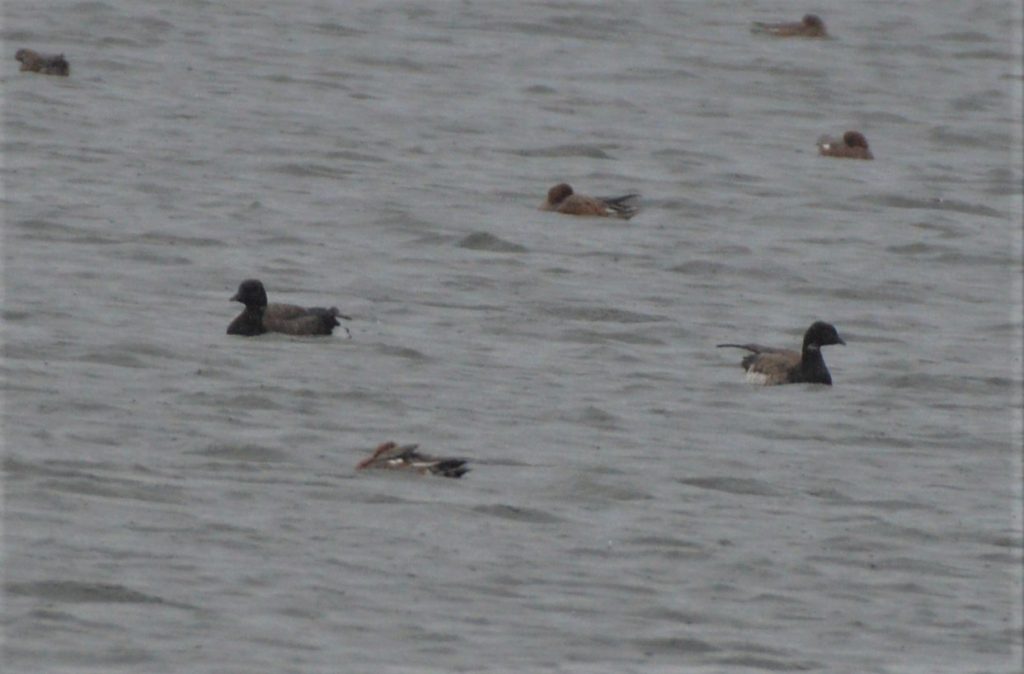Birding For Brents at the Wild Goose Festival 2022
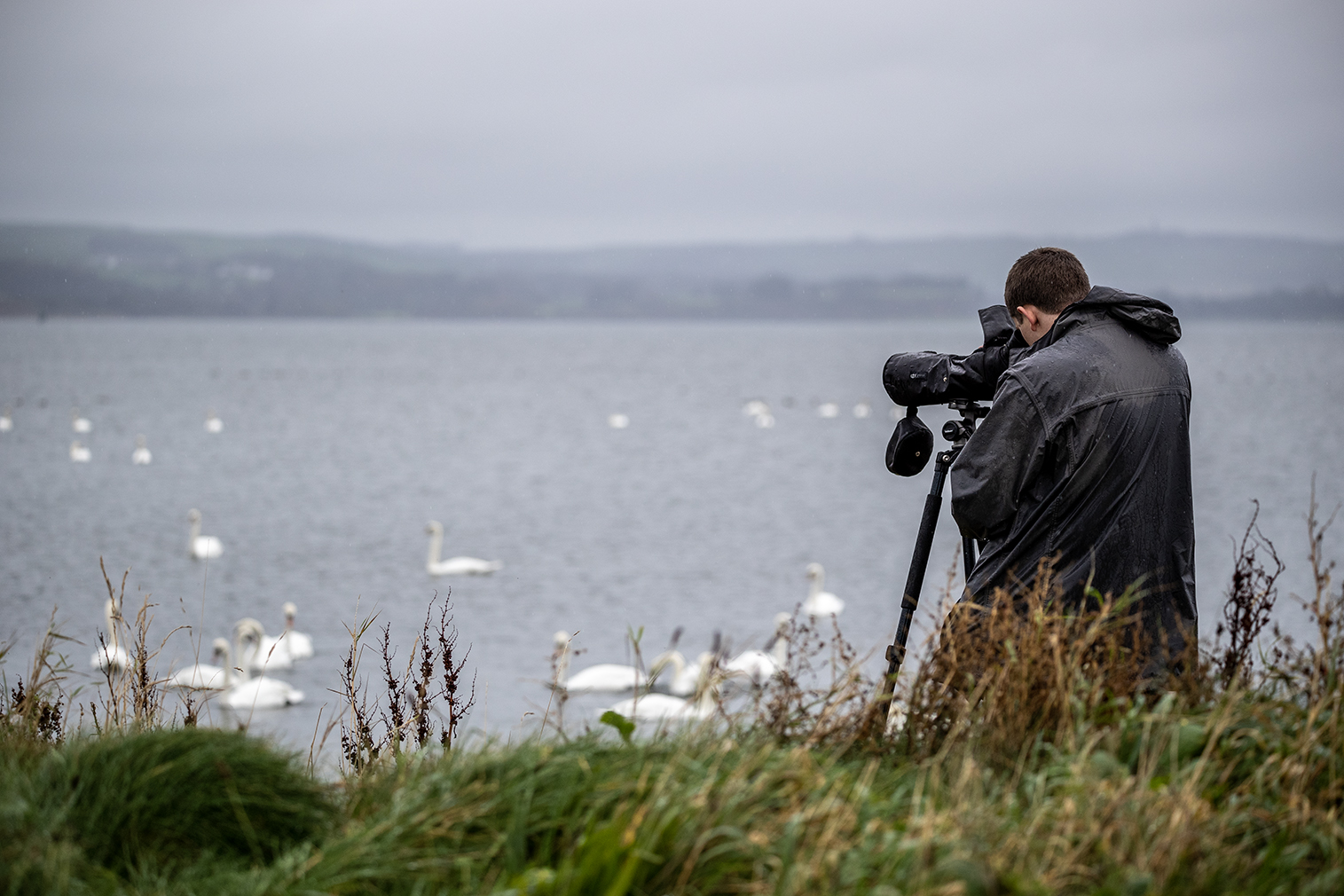
On 23rd October the ‘Birding for Brents’ event was held in Stranraer as part of the Wild Goose Festival 2022. Faith Hillier and Malcolm Haddow from our team co-facilitated the event with Huw Connick from the British Trust for Ornithology (BTO) and David McGhie from the Scottish Ornithologists’ Club (SOC). Despite some authentic Scottish weather, the event was well attended, with 13 braving the deluge.
It was a day of complete contrasts. The rains of the Rhins were relentless, and though attendees were well clad no amount of waterproofs could have saved us from being drenched. Yet despite the weather it was a great day for birdwatching! By the end of the event, 46 species of bird had been sighted – a fine result. Many a birder has gone searching in far better conditions and seen much less. This exciting diversity certainly spurred us onward.

Our main target was the pale-bellied brent goose which Faith had seen in great numbers the week before. However, brents were scarce on the day, and the sum total we counted was 4! We were not disillusioned however, for many a local rarity was sighted.
In Stranraer Harbour a black guillemot in its white winter plumage dived for its supper into the black waters. A great crested grebe preened itself, unruffled by the humans watching. Cormorants decorated the harbours railings in stupor, unaffected by the torrential downpour. A humble pair of little grebes soon dipped for cover once they observed us, clearly shyer than their proud, great crested cousin.
Our troop headed towards the western pier and were greeted by a small flock of turnstone. They continued to forage whilst we watched on, the nearest only 6 feet or less away. Quite brave for such a small bird! Turnstones get their name by prying under stones for any tasty morsels they can find. They are true beachcombers, unfussy about what they find.
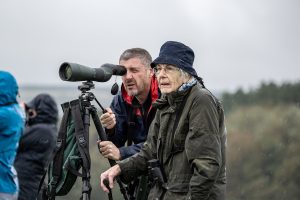
At the head of the pier, we unexpectedly found a kingfisher, betrayed by his own flash of blue. Even the more experienced of our group were surprised to find this species on this turbulent Scottish coast. A brave wren creeping along the stone wave breaks of the harbour took great offense at our presence. It loudly announced our trespassing to the world with its shrill alarm call. Perhaps wrens are the Jack Russells of the bird world, brave and loud for their size!
Off the pier we were excited to spy some rarer pelagic species, including red-throated diver, great northern diver and Slavonian grebe. These birds are primitive in appearance and greatly resemble some of the aquatic proto-birds from the Cretaceous era. Divers (also known as loons) are perhaps most famous for their eerie calls which are commonly used in movies to convey wilderness. The Slavonian grebe, a Red List species, is one of the UK’s rarest breeding birds and largely confined to remote lochs in the north of Scotland. However these birds, along with wintering migrants, can be found along our coastline. Perhaps the strangest fact about this species is that it eats its own feathers! It is theorized that this creates a sieve in the bird’s stomach, keeping larger objects like bones in place to be digested and maximising nutrient absorption efficiency.
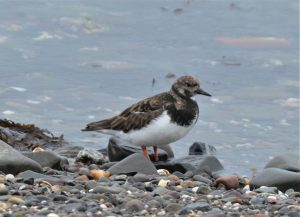
After a while we set off in our cars to a new point at the other side of Loch Ryan, regrouping at the car park by The Bunker. An extensive raft of Eurasian wigeon and greater scaup bobbed on the water. Scaup is another Red List species and perhaps our rarest breeding duck. Most on our shores are winter migrants, though we were excited to see them in such large numbers for they are rarely seen further east in the Solway. It was the wigeons however that dominated the loch and they were visible in all directions. Closer to the shore, inquisitive mute swans trumpeted, no doubt hopeful for a free meal! They were soon accompanied by their cousins the whooper swans who announced their arrival with their characteristics honk, reminiscent of a clown’s car horn. A cheerful flock of redshank elegantly ambled along the shore; their red legs brought us some colour and joy. Waders are the unsung beauties of the birding world, truly the avian equivalent of a Van Gogh or Jaguar E-Type!
Determined to find some brents, we scoured through the innumerable ranks of wigeon and scaup for our prize. The brent is our smallest goose being not much larger than a mallard and thus easily overlooked. At last, through the hoard, we found two pairs of brent geese. Much less than we hoped but relieved we did in fact find some for our Birding for Brents event!
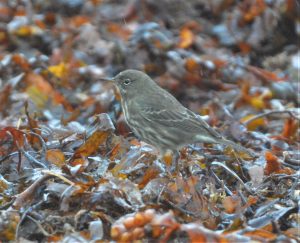
Those eager amongst us headed to The Wig in hope of finding a larger contingent of brent geese. Though the brents eluded us, a fine selection of birds was to be found. A greenshank and green sandpiper foraged together amongst a parcel of Eurasian oystercatchers. Out in the far reaches of the water a raft of common scoter could be seen. Despite their name this is a Red List species that has undergone a drastic decline in recent times. One wonders why we use ‘common’ in species names when so many are now struggling.
Quite bedraggled and drookit, the brave few off us that remained decided to call it a day as somehow the rains of the Rhins increased in ferocity. Despite being soaked to our very cores we left quite satisfied at the number of species we had seen. Loch Ryan is a fantastic and underappreciated place to view wildlife and we are eager to return to see the brents in their full splendour and discover what else calls this avian paradise their home.
Full list of species seen
-

Eurasian oystercatchers Black guillemot (Cepphus grille)
- Black headed gull (Chroicocephalus ridibundus)
- Carrion crow (Corvus corone)
- Common eider (Somateria mollissima)
- Common gull (Larus canus)
- Common redshank (Tringa totanus)
- Common scoter (Melanitta nigra)
- Eurasian curlew (Numenius arquata)
- Eurasian jackdaw (Corvus monedula)
- Eurasian oystercatcher (Haematopus ostralegus)
- Eurasian Wigeon (Mareca Penelope)
- Eurasian wren (Troglodytes troglodytes)
- European Goldfinch (Carduelis carduelis)
- European robin (Erithacus rubecula)
- European rock pipit (Anthus petrosus)
- European shag (Phalacrocorax aristotelis)
-

Common redshank European starling (Sturnus vulgaris)
- Goldeneye (Bucephala clangula)
- Great Black Backed Gull (Larus marinus)
- Great cormorant (Phalacrocorax carbo)
- Great crested grebe (Podiceps cristatus)
- Great northern diver (Gavia immer)
- Greater scaup (Aythya marila)
- Green sandpiper (Tringa ochropus)
- Greenshank (Tringa nebularia)
- Grey heron (Ardea cinerea)
- Greylag goose (Anser anser)
- Herring gull (Larus argentatus)
- House sparrow (Passer domesticus)
- Kingfisher (Alcedo atthis)
-

Pale-bellied brent goose Knot (Calidris canutus)
- Linnet (Linaria cannabina)
- Little grebe (Tachybaptus rufus)
- Mallard (Anas platyrhynchos)
- Mute swan (Cygnus olor)
- Northern pintail (Anas acuta)
- Pale-bellied brent goose (Branta bernicla hrota)
- Pied wagtail (Motacilla alba yarrellii)
- Pink footed goose (Anser brachyrhynchus)
- Red breasted merganser (Mergus serrator)
- Red-throated diver (Gavia stellata)
- Rock dove (Columba livia)
- Ruddy turnstone (Arenaria interpres)
- Slavonian grebe (Podiceps auratus)
- Whooper swan (Cygnus cygnus)
- Wood pigeon (Columba palumbus)
